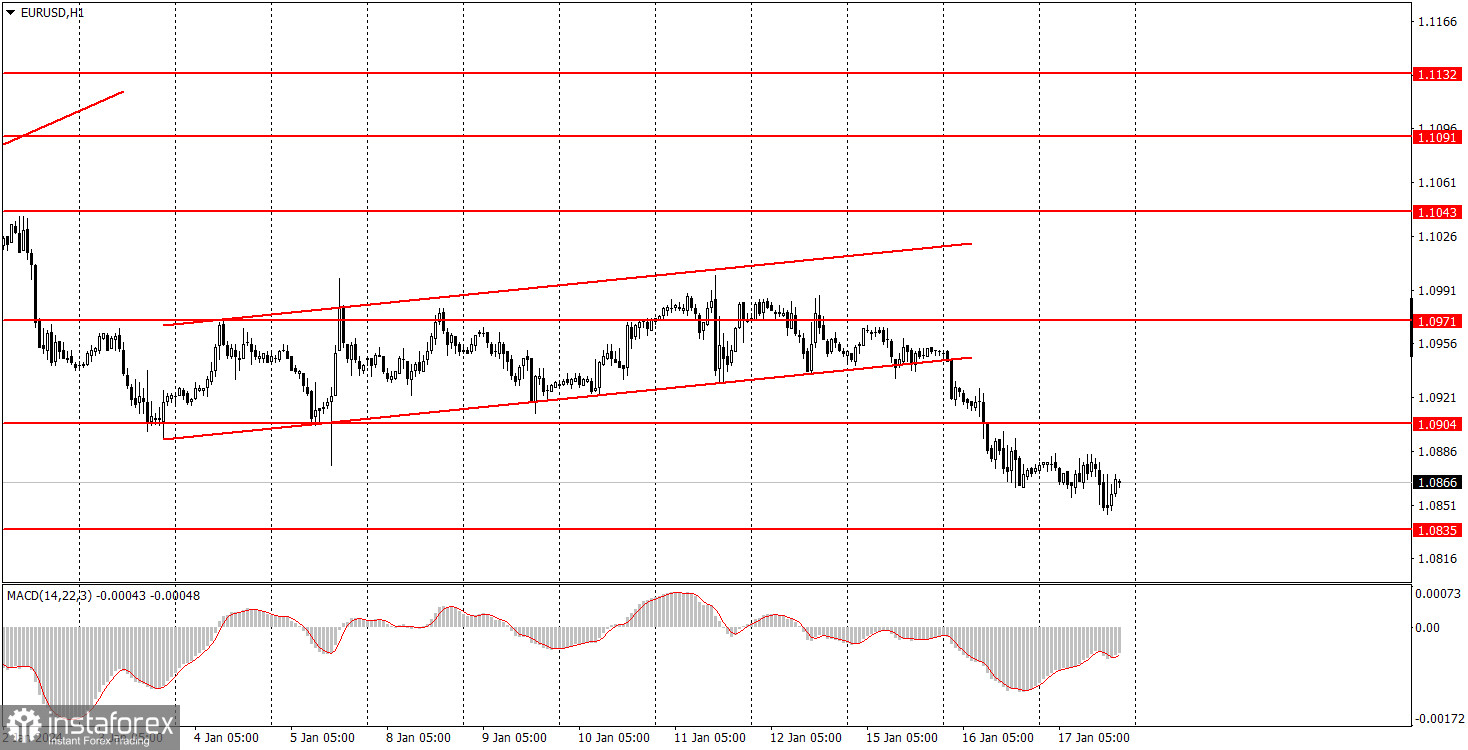Analyzing Wednesday's trades:
EUR/USD on 1H chart

The EUR/USD currency pair continued its overall downward movement throughout Wednesday, although a total flat was observed during the day, which is clearly visible on the 5-minute timeframe. Nevertheless, a couple of days ago, the price consolidated below the upward channel, so the movement downward was anticipated. How long it will continue is very difficult to say, but now, for the first time in several weeks, we have a real technical picture that allows for a strong drop in the euro.
On Wednesday, only secondary data were published in the European Union and the USA. In the EU, it was the Consumer Price Index for December in its second estimate. In the USA, it was reports on industrial production and retail sales. Given the total day's volatility of 40 points, it can be confidently said that the aforementioned reports did not evoke any emotions among traders.
In recent weeks, the market has been buying euros and selling dollars solely based on its assumption that the Federal Reserve will start reducing the rate much earlier than the ECB and will reduce it more significantly by the end of 2024. However, facts suggest, if not the opposite, then something different. Both central banks may start the easing process at about the same time and reduce the rate approximately an equal number of times.
EUR/USD on 5M chart

Not a single trading signal was formed on the 5-minute timeframe on Wednesday. With a volatility of 40 points, this is not surprising. We would even say that it is very good that there were no signals, as they would hardly have been strong and allowed beginner traders to earn. Remember, flat in any of its manifestations is the worst time for traders.
Trading tips on Thursday:
On the hourly timeframe, the EUR/USD pair has every chance of forming a downward trend, as it has consolidated below the upward channel. The macroeconomic statistics on Tuesday had nothing to do with the pair's fall, which is a good sign. Perhaps the market has finally changed its attitude towards the euro and dollar to the opposite.
On Thursday, we will start from the area of 1.0896-1.0904. Around this area, three sell signals were formed on Tuesday, so we consider it reasonable to stay in short positions with a target of at least 1.0835. In perspective, we are expecting a much stronger fall of the pair.
The key levels on the 5M chart are 1.0733, 1.0767-1.0781, 1.0835, 1.0896-1.0904, 1.0940, 1.0971-1.0981, 1.1011, 1.1043, 1.1091, 1.1132-1.1145, 1.1184, 1.1241, 1.1279-1.1292.
European Central Bank President Christine Lagarde will give a speech for the second time this week, while a new series of secondary reports will be released in the U.S. In particular, applications for unemployment benefits, new home sales, and the number of building permits issued will be published. However, these data are secondary and may provoke the same market reaction as Wednesday's similar reports.
Basic trading rules:
- Signal strength is determined by the time taken for its formation (either a bounce or level breach). A shorter formation time indicates a stronger signal.
- If two or more trades around a certain level are initiated based on false signals, subsequent signals from that level should be disregarded.
- In a flat market, any currency pair can produce multiple false signals or none at all. In any case, the flat trend is not the best condition for trading.
- Trading activities are confined between the onset of the European session and mid-way through the U.S. session, after which all open trades should be manually closed.
- On the hourly timeframe, trades based on MACD signals are only advisable amidst substantial volatility and an established trend, confirmed either by a trendline or trend channel.
- If two levels lie closely together (ranging from 5 to 20 pips apart), they should be considered as a support or resistance zone.
- When 15 points are passed in the correct direction, it is advisable to set the Stop Loss to breakeven.
How to read charts:
Support and Resistance price levels can serve as targets when buying or selling. You can place Take Profit levels near them.
Red lines represent channels or trend lines, depicting the current market trend and indicating the preferable trading direction.
The MACD(14,22,3) indicator, encompassing both the histogram and signal line, acts as an auxiliary tool and can also be used as a signal source.
Significant speeches and reports (always noted in the news calendar) can profoundly influence the price dynamics. Hence, trading during their release calls for heightened caution. It may be reasonable to exit the market to prevent abrupt price reversals against the prevailing trend.
Beginners should always remember that not every trade will yield profit. Establishing a clear strategy coupled with sound money management is the cornerstone of sustained trading success.
 English
English 
 Русский
Русский Bahasa Indonesia
Bahasa Indonesia Bahasa Malay
Bahasa Malay ไทย
ไทย Español
Español Deutsch
Deutsch Български
Български Français
Français Tiếng Việt
Tiếng Việt 中文
中文 বাংলা
বাংলা हिन्दी
हिन्दी Čeština
Čeština Українська
Українська Română
Română

